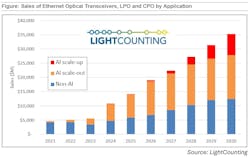Scale-up networks for AI clusters open new optical interconnect opportunities
Ongoing investments by cloud providers in data centers are spurring a new growth trajectory for the optical transceiver market.
A new Light Counting report revealed that a “surge” in AI development created a new wave of demand for optical connectivity in 2023-2025. This will sustain the market’s growth through 2030.
In its latest forecast, the research firm predicts “strong growth” for sales of Ethernet optical transceivers, including re-timed modules, linear drive pluggables (LPO), and co-packaged optics (CPO).
What are scale-up networks?
AI scale-up networks refer to the architecture within a single compute cluster, designed to enhance communication between GPUs, enabling high-bandwidth, low-latency connections for faster processing. These networks are crucial for scaling AI workloads by maximizing the performance of a single system. In an optical network, scaling up involves increasing the capacity and reach of optical networks to handle growing data demands. This is achieved through various techniques, including increasing the capacity per port, utilizing wider fabrics, and leveraging advanced technologies like co-packaged optics and silicon photonics.
Optical scale-up connection
One key area that will be key in future optical growth will be the use of optical connectivity in AI scale-up networks.
Between 2026 and 2030, LightCounting expects co-packaged optics (CPO) to emerge as the best option for connectivity in scale-up networks, due to higher bandwidth density and reliability.
Further, as enthusiasm around AI inevitably tapers off, the research firm said it projects 30-35% annual growth in 2025 and 2026 and 15-20% in 2027-2030.
“Timing of such declines is hard to predict, but we usually see it every 3 years on average,” LightCounting said. “The last two declines in 2019 and 2022 were caused by slower growth in spending of the leading cloud companies and excess inventories piling up across the supply chain.”
Unscathed by the trade war
It appears that the Trump administration’s trade war is not holding up optical transceiver sales to US-based cloud companies or is causing glitches in the broader supply chain right now.
LightCounting noted that restrictions on sales of Nvidia’s GPUs to China, which are being removed now, caused what it called “a pause in demand from Chinese Cloud companies in the last two months, but accelerated growth in Huawei’s business.”
Although the research firm lowered its optical sales forecast for Alibaba, ByteDance, and Tencent in 2025, it raised the 2026 forecast.
Additionally, LightCounting increased its 800G ZR/ZR+ transceiver forecast in 2026-2027 because it said “customers are accelerating transition from on-board to pluggable DWDM modules and using them directly on switches and routers.”
Because AI clusters no longer fit into a single building, LightCounting raised the forecast for coherent-lite transceivers, included in the Ethernet market segment.
In instances where electricity availability is lacking, GPUs need to be installed across various locations. The only thing holding back the build-out of distributed AI clusters is latency.
LightCounting said that “coherent-lite transceivers will address this emerging market opportunity.”
For related articles, visit the Optical Technology section.
For more information on high-speed transmission systems and suppliers, visit the Lightwave Buyer’s Guide.
To stay abreast of fiber network deployments, subscribe to Lightwave’s Service Providers and Datacom/Data Center newsletters.
About the Author
Sean Buckley
Sean is responsible for establishing and executing the editorial strategy of Lightwave across its website, email newsletters, events, and other information products.


